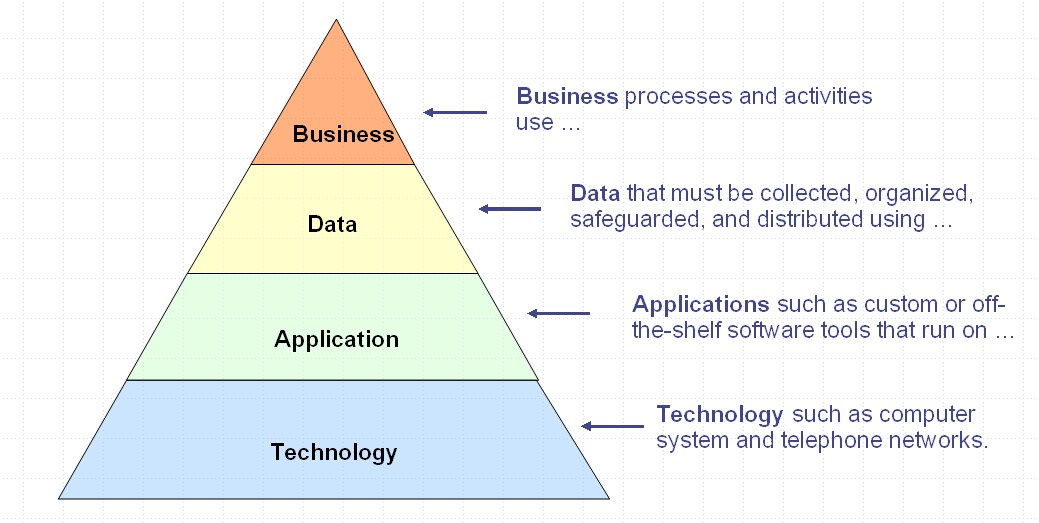Question
In: Computer Science
(quinta/a) Explain what is an Enterprise Architecture Stack with examples.PLEASE write your answer in your own...
(quinta/a) Explain what is an Enterprise Architecture Stack with examples.PLEASE write your answer in your own words!thanks
Solutions
Expert Solution
An enterprise architecture framework (EA framework) defines how to create and use an enterprise architecture. An architecture framework provides principles and practices for creating and using the architecture description of a system. It structures architects' thinking by dividing the architecture description into domains, layers, or views, and offers models - typically matrices and diagrams - for documenting each view.
it has been normal to divide enterprises architecture into four architecture domains.
· Business architecture,
· Data architecture,
· Applications architecture,
· Technology architecture.

Enterprise architecture domains and subdomains
The application and technology domains (not to be confused with business domains) are characterized by domain capabilities and domain services. The capabilities are supported by the services. The application services are also referred to in service-oriented architecture (SOA). The technical services are typically supported by software products.
The data view starts with the data classes which can be decomposed into data subjects which can be further decomposed into data entities. The basic data model type which is most commonly used is called merda (master entity relationship diagrams assessment, see entity-relationship model). The Class, subject and entity forms a hierarchical view of data. Enterprises may have millions of instances of data entities.
The Enterprise Architecture Reference Traditional Model offers a clear distinction between the architecture domains (business, information/data, application/integration and technical/infrastructure). These domains can be further divided into Sub domain disciplines. An example of the EA domain and subdomains is in the image on the right.
Many enterprise architecture teams consist of Individuals with Skills aligned with the Enterprise Architecture Domains and sub-domain disciplines. Here are some examples: enterprise business architect, enterprise documentational architect, enterprise application architect, enterprise infrastructure architect, enterprise information architect, etc.
Enterprise architecture reference architecture with sub domains
Examples:
Here is a list of architecture patterns, and corresponding software design patterns and solution patterns.
|
Sub-domain area |
Architecture pattern |
Software design patterns |
Solution patterns |
Related patterns |
|
Data integration/SOA |
· ETL (data extraction transformation and loading) |
· Change data capture · Near real-time ETL · Batch ETL · Data discovery |
· Error handling · Job scheduling · Data validation · Slowly changing dimensions load |
· EAI · Master data hub · Operational data store (ODS) · Data mart · Data warehouse |
|
· MFT |
||||
|
· EAI/ESB |
· Publish/subscribe · Request/reply · Message exchange patterns |
· One-way · Synchronous request/response · Basic callback · Claim check |
· SOA |
|
|
Data architecture |
· Transaction data stores (TDS/OLTP) · Master data store · Operational data store · Data mart · Data warehouse |
· Custom applications databases · Packaged application databases |
· ETL · EAI · SOA |
|
|
Analytics and business intelligence |
· Transactional reporting · Operational analytics · Business analytics · Predictive analytics · Prescriptive analytics · Streaming analytics · Data science and advanced analytics · NLP |
· Transactional reporting data access · Operational reporting data access · Analytical reporting data access · Analytical dashboard data access · Operational dashboard data access · Data mining |
· Real-time dashboards · In-memory analytics · Statistical analysis · Predictive analytics |
· ETL · EAI · TDS · Operational data store · Data mart |
|
Master data management |
· Master data hub |
· Master data replication · Master data services · Master data synchronization |
· Change data capture · EAI · STD |
|
|
Data modeling |
· Dimensional data modeling · E-R data modeling |
· Modeling standards · Naming conventions |
||
|
Artificial intelligence |
· Decision management · Speech recognition · Text analytics and NLP · Natural language generation · Classic machine learning · Deep learning · Robotic process automation · Image and video analysis |
|
Related Solutions
What is Enterprise Governance and IT Governance in Enterprise Architecture? PLEASE write in your own words!...
Write your own version of a class template that will create a static stack of any...
PLEASE READ CAREFULLY AND EXPLAIN YOUR ANSWER IF POSSIBLE (JAVASCRIPT ONLY) Write out the call stack...
Enterprise Architecture Discuss the impact of Enterprise Architecture changes in any business process model. Especially on...
Discuss in your own words what is meant by client/server architecture.
Federal Enterprise Architecture Framework (FEAF) 2. In what area the architecture framework is used? 3. How...
in one page answer questions below Enterprise architecture (EA) at American Express was the framework the...
Answer in your own words Information governance is a crucial building block for effective enterprise information...
Task 6 – CPU Architecture (20 marks) Please explain in your own words for each part...
What is your understanding about the term ‘Enterprise Cloud Services’? Explain the meaning of word Enterprise...
- If the density of the universe great than a critical value, then it might continue expanding...
- A 16.4-kg block rests on a horizontal table and is attached to one end of a...
- Freud’s theory of defense mechanisms has had a profound impact on the methods used by therapist,...
- discuss what a disclaimer is, when is it is issued, and how it would affect the...
- Explain why 1 additional net ATP is produced when the beginning substrate is glycogen compared to...
- What is Sales Tax, its salient features and how it works, do a comparative analysis between...
- E8-10 (Algo) Computing Depreciation under Alternative Methods LO8-3 Strong Metals Inc. purchased a new stamping machine...
 venereology answered 1 year ago
venereology answered 1 year ago